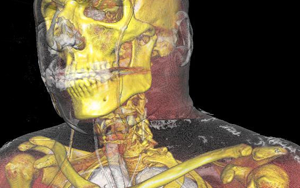 The ImageVis3D team is proud to announce the release of ImageVis3D 2.0. Download ImageVis3D is a desktop volume rendering application which was designed to visualize large data. Support is available for multiple rendering modes, such as 1D and 2D transfer functions, isosurface rendering, as well as specialized modes such as MIP and slice views. On modern systems, ImageVis3D's GPU-accelerated rendering delivers incredible performance, while compatibility options exist to allow ImageVis3D to perform adequately on older systems.
The ImageVis3D team is proud to announce the release of ImageVis3D 2.0. Download ImageVis3D is a desktop volume rendering application which was designed to visualize large data. Support is available for multiple rendering modes, such as 1D and 2D transfer functions, isosurface rendering, as well as specialized modes such as MIP and slice views. On modern systems, ImageVis3D's GPU-accelerated rendering delivers incredible performance, while compatibility options exist to allow ImageVis3D to perform adequately on older systems.ImageVis3D 2.0 is a major release, bringing many new features and a great number of bugfixes. Changes since 1.3 include:
New Features
- ImageVis3D now supports rendering of geometry data mixed with volume renderings.
- A '2D slicing' render method was added for improved GPU compatibility.
- New file formats: Analyze 7.5, Kitware 'MHD', IASS (contributed), 64 bit floating point data in raw format.
- Supported file types can now be dragged and dropped into ImageVis3D from standard file browsers, such as Windows Explorer, Nautilus, or Mac's Finder.
- Support for ImageVis3D Mobile 2.0
- Support for new methods of stereo projections
- RGBA and RGB data can now be rendered with the 1D transfer function
- A batch mode (command line) converter is now distributed as part of ImageVis3D.
Bugs fixed in this release
- Fixed issues reading some DICOM datasets.
- Fixed a problem when dynamically downsampling 16bit data to 8bit data.
- Fixed a long standing rendering bug that occurred in low memory conditions.
- Fixed long standing problems associated with downsampling large histograms.
- Fixed error detection when reading improperly-formatted textual data.
- Fixed issues interpreting data types with the BOV reader.
Changes which are only of interest to developers
- 'Headless' rendering mode for external applications that want to use Tuvok for rendering.
- Abstractions were added to allow one to replace Tuvok's IO layer. See the 'Getting Data into ImageVis3D' manual for more information.
- Added example programs for using Tuvok without ImageVis3D.
Known issues with this release
- The 'Stack' ("stk"), single-file TIFF volume, and Fraunhofer EZRT ("rek") file formats can only be read, not written.
- The 'Brick Of Values' (BOV) reader does not support BOVs in which the data are split across multiple files.
- RGB[A] are the only kinds of multicomponent data supported.
- NVIDIA GPUs on Linux expose a driver issue which can hang the system for prolonged periods of time. To workaround this issue, we recommend sticking with the slice based volume renderer Linux for this release.
- Full-color datasets do not display a proper histogram in the transfer function editors.
- In any mode but MIP, the `Recorder' always uses the highest resolution data, regardless of any other settings.
- In the "Disable LOD" mode of MIP Recordings, progress information is not given. Progress is being made; a visibly-correct rendering is not required to create an on-disk image which is visibly correct.
